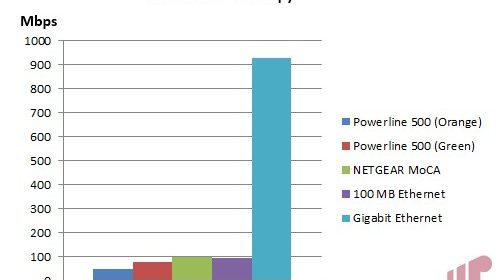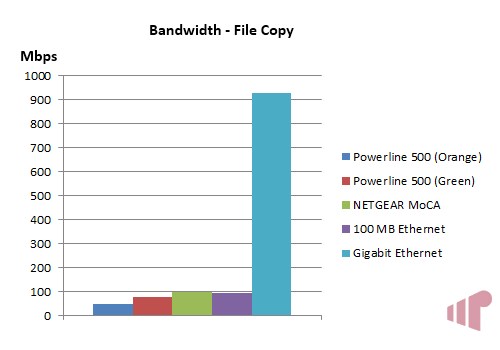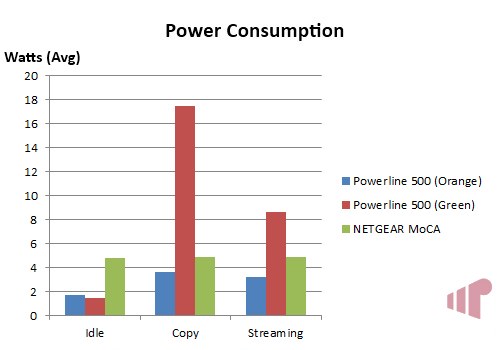Actiontec PWR500 – 500Mbps Powerline Network Adapter Kit

Powerline networking has a reputation for promising capable “hardwired” networking solutions, but historically often fell short when it came to delivery. Having tried a few iterations of the alternative-to-Ethernet over power wires in the past, in my personal experience this reputation has also proved well deserved. Of course with each new generation, the technology evolves and is therefore worth another look. To achieve that goal, Actiontec provided their newest Powerline Network Adapter kit, the PWR500. Supporting up to 500Mbps between nodes, and exposing 100Mbps Ethernet to devices, it should be more than a match for even the most demanding file streaming requirements. Combining this with a price of around $50 for two adapters, it could be the perfect way to extend your media to those hard to reach places around your house or apartment.
The Device
Measuring 2.5” (63.5mm)H x 1.75” (44.45mm)W x 1” (25.4mm)D, the Actiontec PWR500’s size is an outstanding attribute compared to both previous generation Powerline networking products and most competing technologies (e.g. MoCA). The trim physique makes it possible to place the adapter in tandem with most plugs, but the consumption of an outlet can combine with a limitation where it does not work reliably when plugged into a surge protector (i.e. many power strips and receptacle duplicators) to require some careful planning. Adding electrical pass-through would provide additional flexibility, but as it was more annoyance than blocking it is hard to judge too harshly on this point. Other than that minor complaint, the only other nit noted was that the status lights are very bright and flash constantly, which makes them unsuitable for naked use in most media consumption locations. Obviously a bit of electrical tape resolves this problem, but it would be nice if a button (or some other method) were available to disable the indicators during operation.
In Use
The Actiontec PWR500s operate in three modes (Green/Orange/Red) marked by the second (LK) status light on the front of the device, which indicates the quality of the connection. In testing the “Green” (100+Mbps) was reliably observed when connecting both adapters to receptacles on the same circuit. There was some variance when connecting across circuits however, where some would occasionally connect “Green”, but not consistently; even in the same outlets over time. “Orange” (50-99Mbps) was always achievable except in locations with Intermatic Z-Wave outlets installed, where it would not connect at all. GE models worked properly though, so it is not a general issue with Z-Wave receptacles. The “Red” (<50Mbps) state was not producible (a good thing) in any outlet in the house (even those on the exterior in the attic), so it was not possible to test that scenario.
Before moving on, it is worth noting that the underlying implementation is transparent to the end points; so features like wake on LAN (WOL) that work on standard Ethernet, also work when used with the PWR500.

Form factor matters, but not nearly as much as performance. So it was great to discover that the Actiontec PWR500 Powerline Networking adapters, performed well in both raw data transfer and real world use – which included activities like streaming recorded TV, high bitrate (35+ Mbps) video files, and BDMV/VIDEO_TS over a few week time period. Looking more closely at the data, we can see why that was the case, with the PWR500 able to deliver 49Mbps and 78Mbps consistently on Orange and Green respectively. These numbers are lower than what was observed when running the same test using MoCA adapters or 100/1000Mb (Cat6) Ethernet, so while well suited for media consumption, if maximum throughput is a requirement there are better alternatives.
As noted previously, connection quality varied over time, but at no point was the change noticeable besides what was indicated by the status light while consuming media. The technology scales beyond two adapters, so it would be interesting to retest with three or more PWR500 to find out if the fluctuation would have a measurable impact on the mesh when as devices are added.

Media devices sit idle for large periods of time, so it is useful to examine the electricity consumption in an idle state as well as when streaming high bitrate video, and under maximum load. Looking at the data collected, it was interesting to observe the wide variance (1.5-17.5W) in average draw as more bandwidth was demanded, especially against the MoCA adapter; which is relatively constant irrespective of use. A feature not captured in the graph, but also important, is that when not connected to Ethernet the Actiontec adapters enter a low power state where consumption is measurably zero. Obviously, this artifact is not valuable if the connected device keeps its Ethernet interface up while in standby (or “Soft Off”), but if it supports a “deep sleep” or real off mode where the NIC is disabled it is nice to know that the Powerline Networking Adapters will not burn electricity unnecessarily.
Conclusion
My previous experiences with Powerline Networking Adapters were very disappointing, but where those devices failed the Actiontec PWR500 kit produced a reliable, connected media experience. There is no substitute for standard wired Ethernet when it comes to efficiency and bandwidth, but alternative solutions are required where pulling Cat5/6 is impractical, with nothing offering more installation flexibility than Powerline Networking. While in our testing MoCA offered more available bandwidth, it is a costlier alternative compared to the ~$50 Actiontec kit, and offers no tangible benefit for streaming media or anything that requires less than 50Mbps.
Pro:
- Fast enough for even the most demanding media tasks
- Low idle power consumption compared to competing technologies
- Price
Con:
- Electricity consumption relatively high under load scenarios
- Blinking status lights are not suitable for many media consumption locations
- Takes an outlet and does not work properly when connected to a surge protector
Thanks to Actiontec for providing the review sample.

There was a bunch of
There was a bunch of Powerline and MoCa stuff at CES.. where are all these at in release.. When I want one I need to wait….
AFAIK, the networking kit
AFAIK, the networking kit that we saw at CES and promised for this year is out. The really slick multi-path combo devices were still a couple years from retail.